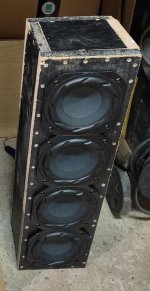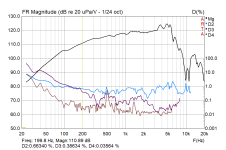@galucha : 🙏
@weltersys : JW's own distortion measurements in the Klippel NFS already showed 1-2% THD @ 96 dB below 300 Hz. 6NDL38 has almost the same Xmax as the 6ND430 - so, hitting the 3% THD limit around 100 dB in the bass region was to be expected.
Most of your other questions are also already answered; such as post #121 revealing that membrane clearance at full excursion was explicitly tested for. 6NDL38 has different chassis edge height to the 6ND6430, so this was adjusted for in the 3D model, and then practice-tested in a test print beforehand.
For completeness, here's a raw measurement of the 4x 6ND430 CB line array at 16 Vrms, equating to 110 dB @ 200 Hz - as you can see, it just barely hits 1% THD. And a pic of the enclosure - net volume per driver around 3l, roughly the same as my Solana mod:


@weltersys : JW's own distortion measurements in the Klippel NFS already showed 1-2% THD @ 96 dB below 300 Hz. 6NDL38 has almost the same Xmax as the 6ND430 - so, hitting the 3% THD limit around 100 dB in the bass region was to be expected.
Most of your other questions are also already answered; such as post #121 revealing that membrane clearance at full excursion was explicitly tested for. 6NDL38 has different chassis edge height to the 6ND6430, so this was adjusted for in the 3D model, and then practice-tested in a test print beforehand.
For completeness, here's a raw measurement of the 4x 6ND430 CB line array at 16 Vrms, equating to 110 dB @ 200 Hz - as you can see, it just barely hits 1% THD. And a pic of the enclosure - net volume per driver around 3l, roughly the same as my Solana mod:


As for listening impressions, the Solana turned out to sound just like a normal PA top. My ears can't make out anything extraordinary. Sorry for the boring description, but it's probably more of a compliment to the speaker than anything else. I listened to up to around 110 dB or so, and at that point, as usual with pretty much all PA tops, the compression driver gets somewhat harsh - but until then, the modded Solana was playing really decent.
That's it. I hope you vicariously enjoyed this little endeavour.
Yes, I did enjoy it ! Nice writeup and documentation. Thx!
It doesn't surprise me that the Solana sounded like a normal PA. I've been building MEH's that have more driver sections than strictly needed, to play with optimum passband strategies, etc. The most was a 5-way all in one large horn, which even though it extended quite low, was designed to be used with a sub. ( I knew the very low extension was high-SPL limited).
What it could do was let me listen to it with the sub, choosing sections.
The compression driver dcx464 was always in play of course (blue and orange traces. I could add just the mids (purple) or just the lows (green), or both of those. (The sub lows (red) would not span up to the CD and could not be used alone).
I found using just the mids took a lot of the MEH appeal away...and started to sound like any other good horn-over-cone trap box with a sub.
Just using the lows was better than just the mids. The mids needed to cross to the sub no lower than about 150Hz. The lows were fine to at least 80Hz.
Point is I think, it just came to to how much of the spectrum, or rather how low in frequency, was the box producing, ....even though a sub was fully along for the ride and dialed in ultra-smoothly.. The lower the extension, the more unique the big MEH sounded.
Rightly or wrongly, I guess I've come to the conclusion that if a MEH gets too small, there's not much advantage over other small designs like a good coax for example.
Absolutely new to this, I'm currently building the Scott Hinson MEH, never even heard any speaker that follows these design principles (unity, synergy, meh). What would you consider too small in this context?I guess I've come to the conclusion that if a MEH gets too small, there's not much advantage over other small designs like a good coax for example.
Absolutely new to this, I'm currently building the Scott Hinson MEH, never even heard any speaker that follows these design principles (unity, synergy, meh). What would you consider too small in this context?
I don't want to say what I think is too small, because, ...... I don't really know !
But I do think that there are two principles in play that form a continuous transition range that helps a MEH come through with the magic ......the lower its frequency extension, and the larger the physical size of the box. Just makes for a bigger butt point source !!
Personally, I try very hard to get any design to reach a 100Hz crossover with full SPL capability. That said, the MEH version I'm currently running as my favorite only makes it to 120Hz, but it's without reflex ports so I forgive it 🙂
I think Scott's design is really cool, how he augmented it with ports....no problem with reaching lower there.
The size of the horn is mainly about how low pattern control extends, which will never come close to how low in frequency response the MEH goes. (unless maybe your name is Danley !)
